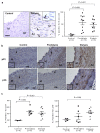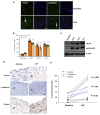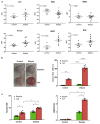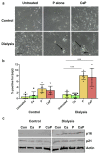Arterial "inflammaging" drives vascular calcification in children on dialysis
- PMID: 30827513
- PMCID: PMC6684370
- DOI: 10.1016/j.kint.2018.12.014
Arterial "inflammaging" drives vascular calcification in children on dialysis
Abstract
Children on dialysis have a cardiovascular mortality risk equivalent to older adults in the general population, and rapidly develop medial vascular calcification, an age-associated pathology. We hypothesized that premature vascular ageing contributes to calcification in children with advanced chronic kidney disease (CKD). Vessels from children with Stage 5 CKD with and without dialysis had evidence of increased oxidative DNA damage. The senescence markers p16 and p21 were also increased in vessels from children on dialysis. Treatment of vessel rings ex vivo with calcifying media increased oxidative DNA damage in vessels from children with Stage 5 CKD, but not in those from healthy controls. Vascular smooth muscle cells cultured from children on dialysis exhibited persistent DNA damage, impaired DNA damage repair, and accelerated senescence. Under calcifying conditions vascular smooth muscle cells from children on dialysis showed increased osteogenic differentiation and calcification. These changes correlated with activation of the senescence-associated secretory phenotype (SASP), an inflammatory phenotype characterized by the secretion of proinflammatory cytokines and growth factors. Blockade of ataxia-telangiectasia mutated (ATM)-mediated DNA damage signaling reduced both inflammation and calcification. Clinically, children on dialysis had elevated circulating levels of osteogenic SASP factors that correlated with increased vascular stiffness and coronary artery calcification. These data imply that dysregulated mineral metabolism drives vascular "inflammaging" by promoting oxidative DNA damage, premature senescence, and activation of a pro-inflammatory SASP. Drugs that target DNA damage signaling or eliminate senescent cells may have the potential to prevent vascular calcification in patients with advanced CKD.
Keywords: aging; calcification; dialysis; senescence; vascular smooth muscle cells.
Copyright © 2019 International Society of Nephrology. Published by Elsevier Inc. All rights reserved.
Conflict of interest statement
All the authors declared no competing interests.
Figures








Comment in
-
Arterial "inflammaging" drives vascular calcification in children on dialysis.Kidney Int. 2019 Aug;96(2):522. doi: 10.1016/j.kint.2019.05.021. Kidney Int. 2019. PMID: 31331477 No abstract available.
-
The authors reply.Kidney Int. 2019 Aug;96(2):523. doi: 10.1016/j.kint.2019.05.020. Kidney Int. 2019. PMID: 31331479 No abstract available.
References
-
- Goodman WG. Vascular calcification in end-stage renal disease. J Nephrol. 2002;15(suppl 6):S82–S85. - PubMed
-
- Goodman WG, Goldin J, Kuizon BD, et al. Coronary-artery calcification in young adults with end-stage renal disease who are undergoing dialysis. N Engl J Med. 2000;342:1478–1483. - PubMed
-
- Goodman WG, London G, Amann K, et al. Vascular calcification in chronic kidney disease. Am J Kidney Dis. 2004;43:572–579. - PubMed
-
- London GM, Marchais SJ, Guerin AP, Metivier F. Arteriosclerosis, vascular calcifications and cardiovascular disease in uremia. Curr Opin Nephrol Hypertens. 2005;14:525–531. - PubMed
-
- Foley RN, Parfrey PS, Sarnak MJ. Clinical epidemiology of cardiovascular disease in chronic renal disease. Am J Kidney Dis. 1998;32:S112–S119. - PubMed
Publication types
MeSH terms
Substances
Grants and funding
LinkOut - more resources
Full Text Sources
Medical
Research Materials
Miscellaneous

